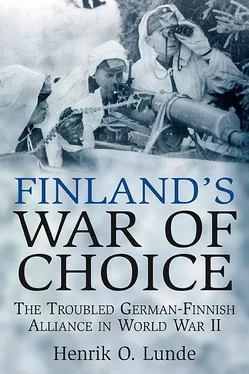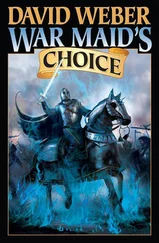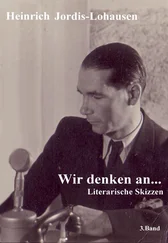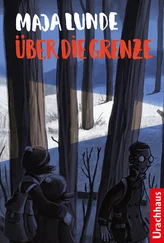Preface and Acknowledgments
1. Olli Vehviläinen, Finland in the Second World War. Between Germany and Russia. Translated by Gerard McAlester (New York: Palgrave, 202), p.ix.
2. John H. Wuorinen, editor, Finland and World War II, 1939–1940 (New York: The Ronald Press Co, 1948), p.4. The actual author of the book was Professor Arvi Korhonen who wrote the manuscript in 1945. Due to the political situation it was not considered possible to publish the manuscript under the real author’s name as the tone was clearly anti-Soviet. Professor Korhonen later became known as the father of the “drifting log theory.” This information, provided by Jukka Juutinen, is from Jari Leskinen and Antti Juutilainen (editors), Talvisodan pikkujättiläinen (WSOY, 2009), p.29 and Ohto Manninen, Molotovin cocktail-Hitlerin sateenvarjo (Painatuskeskus Oy, 1994), pp.144–145.
3. Waldemar Erfurth was also a doctor of philosophy and authored several books on military history and strategy. He also served as the official Wehrmacht historian.
1. Wuorinen, op. cit., p.43.
2. Carl Gustaf von Mannerheim, The Memoirs of Marshal Mannerheim. Translated by Count Eric Lewenhaupt (New York: E. P. Dutton & Company, Inc., 1954), pp.285–286.
3. Väinö Tanner, Finlands Vag 1939–1940 (Stockholm: Albert Bonniers Forlag, 1950), p.13 and William L. Shirer, The Challenge of Scandinavia (Boston: Little, Brown and Company, 1955), pp.324–325.
4. Foreign Ministry Document as cited in Tanner, op. cit., p.15.
5. Tanner, op. cit., pp.24–25.
6. Ibid, p.25.
7. Mannerheim, Memoirs, p.301.
8. Sontag, Raymond James and Beddie, James Stuart, editors. Nazi-Soviet Relations 1939–1941 (hereinafter NSR) (German Foreign Office Documents released by the US Department of State. New York: Didier, 1948), p.78.
9. Wuorinen, op. cit., p.50.
10. It is worth noting that Winston Churchill showed considerable sympathy for the Soviet claims and advised that it would be a mistake to encourage the Finns not to make concessions. See David Reynolds, In Command of History (New York: Random House, 2005), p.121.
11. Finland, Ministry of Foreign Affairs. The Development of Finnish–Soviet Relations During the Autumn of 1939 in the Light of Official Documents (hereinafter Documents Concerning Finnish–Soviet Relations) (Helsinki: FMU, 1940), pp.42–45.
12. Germany. Auswärtiges Amt. Documents on German foreign policy, 1918–1945 (hereinafter DGFP) (Washington: US Government Printing Office, 1954), volume 8, p.240, Document No 206.
13. Ibid, volume 8, p.240, Document No 215.
14. Tanner, op. cit., pp.39–41.
15. DGFP, volume 8, p.248, Document No 223.
16. Ibid, volume 8, p.251, Document No 226.
17. Ibid, volume 8, p.267, Document No 240.
18. Ibid, volume 8, p.252, Document No 227.
19. Ibid, volume 8, p.252, Document No 228.
20. Ibid, volume 8, p.255, Document No 232.
21. Documents Concerning Finnish–Soviet Relations, p.49.
22. Mannerheim, Memoirs, p.311 lists the size of territory the Soviets were willing to give up in East Karelia as 3,455 square miles (8,948 square kilometers).
23. Wuorinen, op. cit., p.58.
24. Hugh Shearman, Finland. The Adventures of a Small Power (London: Stevens and Sons Limited, 1950), p.89.
25. DGFP, volume 8, p.469, Document No 404.
26. Ibid, volume 8, p.268, Document No 241.
27. Wuorinen, op. cit., p.69.
28. Mannerheim, Memoirs, p.359.
29. DGFP, volume 8, p.651, Document No 526.
30. Ibid, volume 8, p.706, Document No 574.
31. Churchill, Winston S. The Second World War. The Gathering Storm (Boston: Houghton Mifflin Company, 1948), pp.538–548.
32. Tanner, op. cit., p.271.
33. DGFP, volume 8, p.774, Document No 612.
34. Ibid, volume 8, p.778, Document No 617.
35. Ibid, volume 8, p.869, Document No 661.
36. Wuorinen, op. cit., p.76.
37. Mannerheim, Memoirs, p.370 and Richard W. Condon, The Winter War. Russia against Finland (New York, Ballantine Books, 1972), p.153.
38. Mannerheim, Memoirs, p.388.
39. DGFP, volume 8, p.650, Document No 526.
40. Harold C. Deutsch. Presidential address presented on December 27, 1946, at the 25th Anniversary meeting of Phi Alpha Theta, held in New York jointly with the meeting of the American Historical Association.
41. General Otto Ruge, the commander in chief of the Norwegian Armed Forces, sent a courier to Marshal Mannerheim at the end of the conflict in Norway. This courier, Captain Tage Ellinger, was asked about the military situation in Norway. After Captain Ellinger completed his briefing, Marshal Mannerheim remarked caustically that it was lucky for Finland that English troops had not come to help during the Winter War. Tage Ellinger, Den Forunderlige Krig (Oslo: Gyldendal Norsk Forlag, 1960), p.116.
42. Trygve Sandvik, Operasjonene til lands i Nord-Norge 1940 (Oslo: Forsvarets Krigshistoriske Avdeling, 1965), volume 2, p.334 and Birger Gotaas, Fra 9. april til 7. juni. Episoder og opplevelser fra krigen i Norge (Oslo: J. Dybwand, 1945), p.229.
43. Halder War Diary, entry for July 21, 1940.
44. Walter Warlimont, Inside Hitler’s Headquarters 1939–45. Translated by R. H. Barry (Novato, California: Presidio Press, 1964), pp.112–114. Warlimont notes that Hitler had already hinted at the necessity of dealing with the Soviet Union earlier in 1940, even before the campaign in the west was concluded.
45. Albert Speer, Erinnerungen (Frankfurt am Main, 1969), p.188.
46. Warlimont, op. cit., p.112.
47. The preparations continued based on Hitler’s verbal order on July 29 and 31. This order was confirmed in September 1940.
48. Halder War Diary, entries for July 21 and 30, 1940.
1. C. Leonard Lundin, Finland in the Second World War (Bloomington: Indiana University Press, 1957), p.80.
2. Ernst von Born, Levnadsminnen (Helsingfors: Sönderström, 1954), pp.327–375.
3. Carl Olof Frietsch, Finlands Ödesår 1939–1943 (Helsingfors, Sönderström, 1945), p.244.
4. Earl F. Ziemke, The German Northern Theater of Operations 1940–1945 (Washington, D.C.: Department of the Army (Pamphlet No. 20–271), 1959), p.115.
5. Wipert von Blücher, Gesandter zwischen Diktatur und Demokratie (Wiesbaden: Limes Verlag, 1951), p.194.
6. Ibid. pp.194–195, 197.
7. DGFP, volume 8, Nos. 310 and 398.
8. Halder’s diary for July 22 mentions Finland as one route by which to attack the Soviet Union.
9. Messages from Zotov to Molotov on July 12 and August 1, 1940, as cited in Vehviläinen, op. cit., p.82.
10. Veltjens, a highly decorated pilot, was an old friend of Göring from WWI. He was engaged in what can be called the business of arms dealing.
11. NSR, Foreign Office Memorandum w/4646/40g, dated October 8, 1940.
12. Mannerheim, Memoirs, pp.399–400.
13. Prime Minister Risto Ryti held two positions at this time. He was Prime Minister but also acting President because President Kyösti Kallio was ill.
14. The delivery of arms to Finland and the presence of German troops on its soil were violations of the spheres of influence established in the secret protocol of the Ribbentrop-Molotov Pact. However, it can be argued that the Soviet Union had already violated the secret protocol when it occupied Lithuania in 1940 since the agreement called for the Soviet sphere of influence to stop at the northern border of that country.
15. Blücher, op. cit., p.198.
16. Ibid, p.198.
17. Ibid, p.221.
18. Hjalmar J. Procopé, editor, Fällande dom som friar (Stockholm: Fahlcrantz & Gumælius, 1946), pp.67–68.
19. Blücher, op. cit., pp.198–199.
20. Mannerheim, Memoirs, p.427.
Читать дальше












